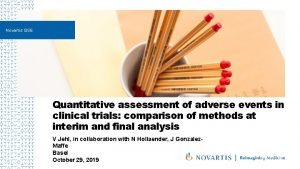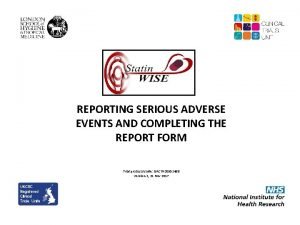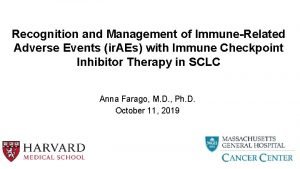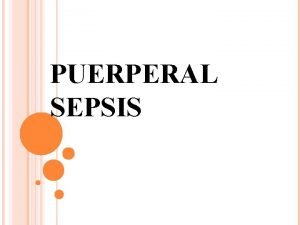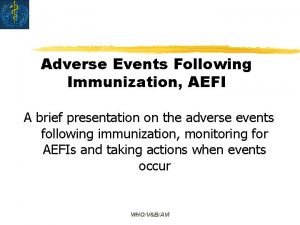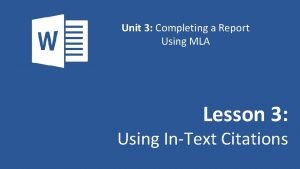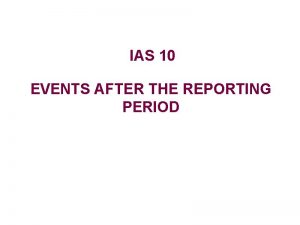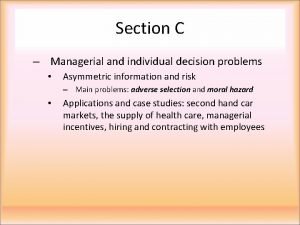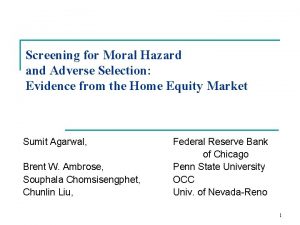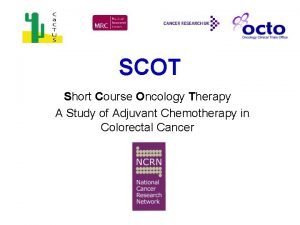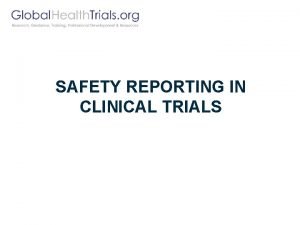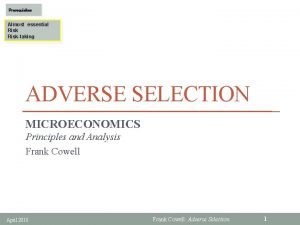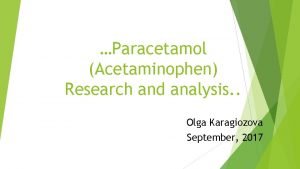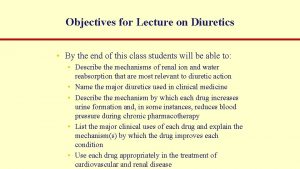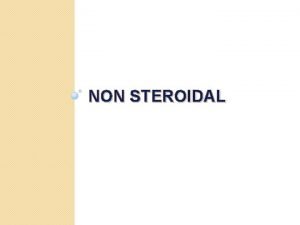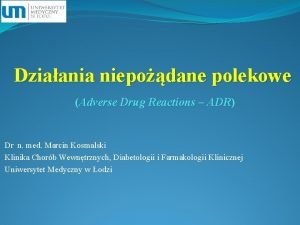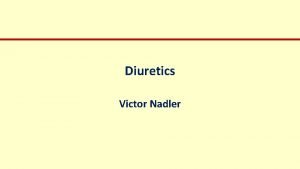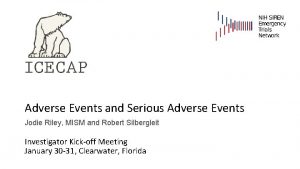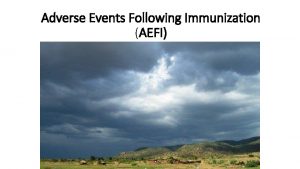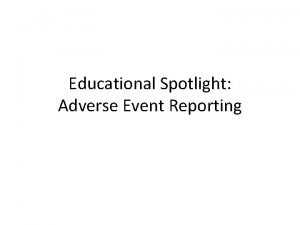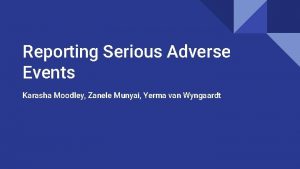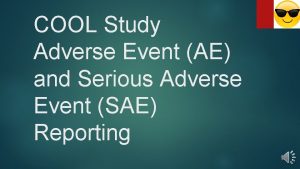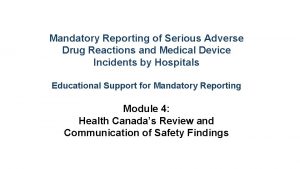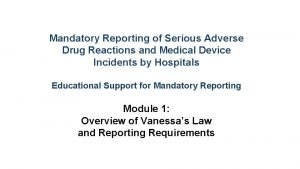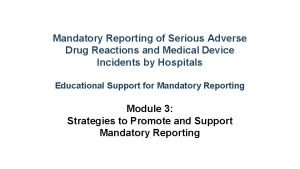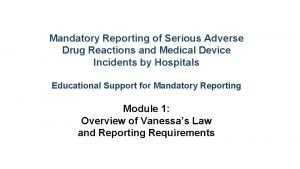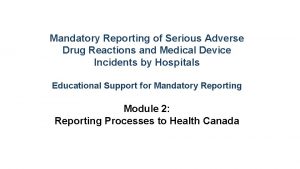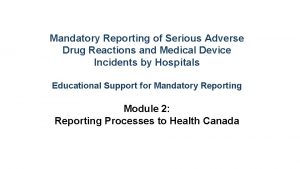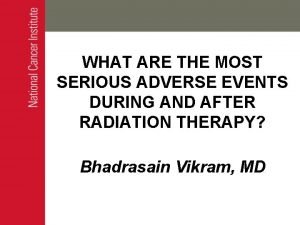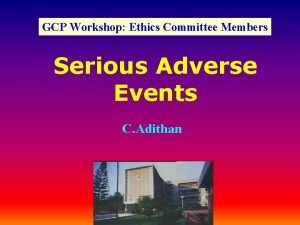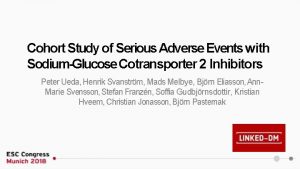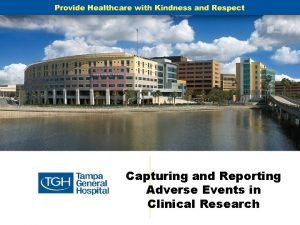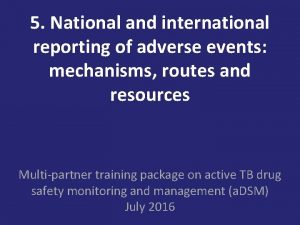REPORTING SERIOUS ADVERSE EVENTS AND COMPLETING THE REPORT
























- Slides: 24

REPORTING SERIOUS ADVERSE EVENTS AND COMPLETING THE REPORT FORM Trial protocol code: ISRCTN 30952488 Version 2, 21 Nov 2017

USE THIS PRESENTATION WITH: 1. The Trial Protocol (Section 2. 9) and 2. Guidance for investigators: SERIOUS ADVERSE EVENT REPORTING AND COMPLETING THE REPORT FORM (Folder 1, Section 7 “Adverse Events” in ISF)

Statin. WISE Definitions Adverse Event (AE) for Statin. WISE trial Serious Adverse Event (SAE) Adverse Reaction (AR) Serious Adverse Reaction (SAR) Suspected Unexpected Serious Adverse Reaction (SUSAR) Any untoward medical occurrence not listed in the Investigational Medicinal Product Dossier (IMPD) and/or Sm. PC for Atorvastatin 20 mg tablets affecting a trial participant during the course of the Statin. WISE trial A serious adverse event is any untoward medical occurrence not listed in the in Investigational Medicinal Product Dossier (IMPD) and/or Sm. PC for Atorvastatin 20 mg tablets affecting a trial participant during the course of the Statin. WISE trial that at any dose results in death; is life-threatening; requires in-patient hospitalisation or prolongation of existing hospitalisation; results in persistent or significant disability/incapacity; or is a congenital anomaly/birth defect. An adverse event when there is at least a possibility that it is causally linked to a trial drug or intervention SAE that is thought to be causally linked to a trial drug or intervention An unexpected occurrence of a SAR; there need only be an index of suspicion that the event is a previously unreported reaction to a trial drug or a previously reported but exaggerated or unexpectedly frequent adverse drug reaction.

What should be reported in the Statin. WISE trial? Serious Adverse Events (SAE) are reported in the STATINWISE trial A serious adverse event is any untoward medical occurrence not listed in the in Investigational Medicinal Product Dossier (IMPD) and/or Sm. PC for Atorvastatin 20 mg tablets affecting a trial participant during the course of the Statin. WISE trial that at any dose results in death; is life-threatening; requires in-patient hospitalisation or prolongation of existing hospitalisation; results in persistent or significant disability/incapacity; or is a congenital anomaly/birth defect.

When should SAEs be reported? Ø Events are reportable from the point of Randomisation Ø SAEs must be reported within 24 hours when the site becomes aware of them Ø PI must verify all SAEs

How are SAEs reported? Ø Complete the form online on the database OR Ø Complete the form provided in Section 7 of the Investigator Site File

Reporting Serious Adverse Events Ø All fields must be completed – do not leave blank fields. If the information is not known at the time of completing the form, write NK (not known) or NA (not applicable). Ø The information supplied on the form must be consistent with the data recorded in the source data i. e. medical records and other data forms. Ø The Initial form should be submitted even if there is only limited information. When any additional or relevant information becomes available, it should be submitted on follow-up report forms – there may be more than one follow-up form. If the event is serious, then follow-up data must be sent to the CTU within 24 hours. Ø In the follow-up report form, you must complete the header information (to identify the patient), the diagnosis must be completed (to identify the event) and only new or corrected information must be reported. Please note that the information provided in the follow-up report form supersedes the information previously reported. Ø The Initial report form should be submitted even if there is only limited information. When any additional or relevant information becomes available, it should be submitted to the CTU. If the form was initially submitted via the database, the form can be updated online. If the form was submitted on paper, additional forms can be submitted as follow-ups.

Reporting Adverse Events Ø When updating the online form or submitting a follow-up report, the diagnosis (question 6) must be entered (to identify the event) and only new or corrected information must be reported. If using paper forms, you must also complete the header information (to identify the patient). Please note that the information provided in follow-up reports supersedes the information previously reported. Ø SAEs that occur throughout the trial will be reported by the CTU to required authorities. Ø Completed paper forms can be sent by FAX to +44(0)20 7299 4663 or attached to an email and sent to statinwise@Lshtm. ac. uk Ø All fields must be completed – do not leave blank fields. If the information is not known at the time of completing the form, write NK (not known) or NA (not applicable). Ø The information supplied on the form must be consistent with the data recorded in the source data i. e. medical records and other data forms.

Reporting Adverse Events Ø In the follow-up report form, you must complete the header information (to identify the patient), the diagnosis must be completed (to identify the event) and only new or corrected information must be reported. Please note that the information provided in the follow-up report form supersedes the information previously reported. Ø Completed forms can be sent by FAX to +44(0)20 7299 4663 or as a scanned image/s attached to an email to statinwise@Lshtm. ac. uk IF YOU NEED URGENT ADVICE ABOUT REPORTING AN ADVERSE EVENT PLEASE CALL: +44 207 299 4684 (Mon-Fri, 9 am-5 pm) OR +44(0)7768 707500 (outside of office hours)

How to complete the Adverse Events reporting form

Using the Database 1. Select the appropriate boxes indicating if the event is an SAE and which criteria are fulfilled.

Using the Database 2. Select “INITIAL” if this is the first time the SAE is being reported Select “FOLLOW-UP” for any subsequent information about the event. Select “FINAL” if this is the last report concerning this event. 3. Select the name of the country where the site is located 4. Enter the patient’s date of birth. 5. Indicate as appropriate

Using the Database 6. Enter the diagnosis if possible, otherwise the signs / symptoms relating to the event. 7. Indicate if this event is due to the progression of underlying illness. 8. Please insert the date when the first signs of the event were noted.

Using the Database 9. Indicate whether or not you suspect the event is related to atorvastatin or placebo. NOT SUSPECTED: this is when a causal relationship between the event and administration of the trial drug is considered unlikely. SUSPECTED: the temporal relationship of the event to trial drug administration makes a causal relationship possible.

Using the Database 10. Complete as appropriate. If the patient made a complete recovery or recovered with sequelae, enter the recovery date. If the patient died, enter the date of death. 11 a. Insert the date the trial treatment started (if known) 11 b. Enter when the trial treatment ended

Using the Database 12. Enter the time between LAST trial drug administration and ONSET of first signs / symptoms 13. Select the appropriate route of administration of the trial treatment 14. Refer to protocol page 17 Unblinding 15. Enter the patient’s height in centimetres. 16. Enter the patient’s weight in kilograms.

Using the Database 17. List here any medical conditions, allergies or similar experiences from the patient’s past history. 18. List all concomitant medications, their start and end dates and the indication for use (if using paper and there is not enough space, use a separate sheet).

Using the Database 19. Add any comments in this section. Note here if the SAE is considered to be caused by any concomitant medication and state which medication is suspected. 20. Please select ALL that apply. Details of adjusted dosages and therapies given can be stated in field 22. 21. List all test/laboratory findings relevant to the diagnosis.

Using the Database 22. Fully describe the nature, severity, cause and any other information that helps understanding of the SAE. Describe therapeutic measures taken and, if available, outcome details. 23. Please state full name and provide a direct telephone number at which you may be directly contacted. 24. The Principal Investigator review the final report 25. Please enter the date this form was completed.

If Using Paper Form: Ø Ø The form is 3 pages-long All fields MUST be completed in the header on EACH page All 3 pages MUST be completed ALL fields must be completed in legible writing and in ball pen ink.

How to make corrections on the AE report form HOW TO MAKE CORRECTIONS On paper: If you enter an incorrect value on the paper form: a) Draw a single line through the incorrect value so it is still visible b) enter the correct value alongside the value location c) date and initial each change Online: a) Select the patient on the database and view the AE form b) Select ‘edit AE’ option c) Make the required changes d) Complete the ‘reason for edit’ field and enter your unique pin (used for log in) before pressing ‘Submit’

How to submit the paper reporting form The form must be Faxed to +44(0)20 7299 4663 or emailed to statinwise@Lshtm. ac. uk Please store any original paper forms in Section 15 of the Investigator Site File

Reporting Serious Adverse Events Ø For serious adverse events that fulfil ANY of the seriousness criteria, all 3 pages of the form must be completed and sent to the CTU WITHIN 24 HOURS of you becoming aware of the event. If in doubt: Please report or call us for advice

CONTACT US London School of Hygiene & Tropical Medicine Room 180, Keppel Street, London WC 1 E 7 HT Tel +44(0)20 7299 4684 Fax +44(0)20 7299 4663 Email: statinwise@Lshtm. ac. uk
 Serious adverse event reconciliation
Serious adverse event reconciliation Novartis adverse event reporting
Novartis adverse event reporting Ahca adverse incident reporting
Ahca adverse incident reporting Adverse events in hospital
Adverse events in hospital Adverse events in hospital
Adverse events in hospital Puerperal sepsis meaning
Puerperal sepsis meaning Adverse events following immunization (aefi) course answers
Adverse events following immunization (aefi) course answers Completing a report using mla quizlet
Completing a report using mla quizlet Events after the reporting date
Events after the reporting date Mutually exclusive vs non mutually exclusive
Mutually exclusive vs non mutually exclusive Status progress report
Status progress report Adverse reaction definition
Adverse reaction definition Sentinel near miss reporting
Sentinel near miss reporting Adverse selection
Adverse selection Adverse selection
Adverse selection Adverse reaction definition
Adverse reaction definition Adverse reaction definition
Adverse reaction definition What is adverse selection
What is adverse selection Effects of paracetamol
Effects of paracetamol Loop diuretics adverse effects
Loop diuretics adverse effects Mechanism of action of acetaminophen
Mechanism of action of acetaminophen Tradjenta to januvia conversion
Tradjenta to januvia conversion Adverse selection
Adverse selection Adr adverse drug reaction
Adr adverse drug reaction Furosemide side effects
Furosemide side effects

